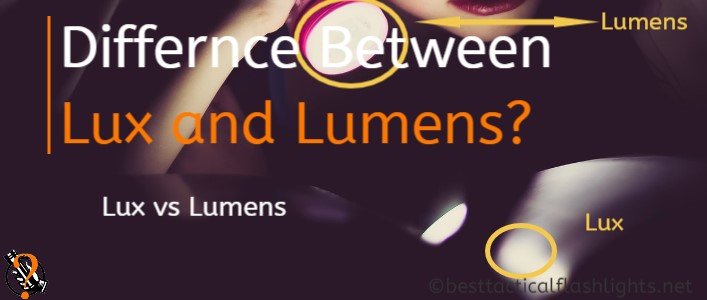A question that comes up a lot is what the difference between Lux and Lumens is.
The two light measurements that show up on the ANSI FL1 charts for flashlights are Lumens and Peak Beam Intensity which is measured in Candela.
Candela is the amount of light that shines in a specific direction. The new version of Candle Power.
So where does lux come in?
What is Lux?
Lux is the amount of light that hits a surface.
Since Lux has to do with the actual light hitting a surface there is an adjustment for distance. To get from Candela to Lux we need to divide Candela by distance in meters squared.
So the equation is Lux = Candela/(distance)^2.
Now Lux comes in on the ANSI FL1 chart in one other place, Beam Distance.
The definition of beam distance is how far the light will throw a beam until the amount of light that falls on a target is 0.25 Lux.
0.25 Lux is the amount of light that comes from a full moon on a clear night.
What are Lumens?
Lumens is total light output. For more specifically about Lumens go here.
So if you took all of the light that came out of the light and gathered it and measured it that would be lumens.
When we are talking about flashlights there can be two different Lumen measurements that show up.
Some of the less trustworthy manufacturers list the LED emitter total output as the lumens for the flashlight.
But, there is loss in light in directions that do not come out of the front of the flashlight.
Reputable flashlight manufacturers will use the Out The Front (OTF) Lumens and actually measure the quantity of light coming out of the flashlight instead of just the capability of the LED emitter.
Difference Between Lux and Lumens
So both of these are ways to measure light.
Lux is how much light hits a specific target and it incorporates distance from the light source.
Lumens is the total amount of light that comes out of the light source.
The thing attaching the two is Candela which is the amount of light that comes out of the light source in a specific direction.
When To Use Lux vs When To Use Lumens?
Lumens have become a good marketing measurement for flashlight manufacturers but without knowing Beam Distance, Beam Angle, and Peak Beam Intensity Lumens does not mean much.
We have lights that are only 2500 Lumens but they can shoot a beam over a kilometer (1180 meters). We also have lights that are 1300 Lumens that have a very large Beam Angle and can only shoot a beam around 350 meters.
Since Lux is the amount of light that hits a surface it is a great measurement to use for photography, lighting design, and lighting up a room.
Lumens are a decent measurement to use when purchasing light sources so you have an idea of how much power they will output.
Beam Angle
So why can a light with way more lumens have less Beam Distance, Peak Beam Intensity, and Lux?
This has to do with Beam Angle. What is the reflector doing or is there even a reflector?
The job of the reflector is to get the light going in a specific direction. So the bigger and deeper the reflector is the more concentrated the Lumens can be in a direction.
So you can have less Lumens but a big and deep reflector and shoot a beam further and have higher lux further away.
All of this works into the idea of beam angle.
This is the main difference between light that are designed to flood or throw. We find that flood lights are usually the lights with the most power, while the lights with bigger reflectors and tighter beam angles are the long range lights.
How To Measure Lux vs Lumens
To measure Lux we will use a lux meter. The Lux meter is a small target and it can tell how much light is hitting it.
Pick a distance and find the brightest spot and record the Lux.
Once we have the Lux we can use the distance from the light and find Candela.
We have another article that is all about how to measure Lumens.
In short you need to have something that will collect all of the light and mix it up so there is no hotspot. Then when you measure how much is coming out you can use the Lux rating and Candela to find the Lumens that are coming out of the front of the flashlight.
The official way to measure Lumens is to use an Integrating Sphere which is a hollow ball with an inner surface that lets the light bounce all around before finally hitting a spot with a measurement device.
If you follow the link above we have a couple DIY options that people have come up with since real integrating spheres are really expensive.
Conclusion
So what does all of this mean?
It means for buying a flashlight you should know what you want to use it for. Just looking at Lumens will not help you since the way that the light acts depends on so many other factors.
The difference between Lux and Lumens is that Lux measures light hitting a surface and Lumens measures light coming out of a light source.
If you are looking to buy a flashlight we have lots of buyers guides depending on what you are looking for. We recommend going to our page that lists out all of our Flashlight Buyers Guides.
